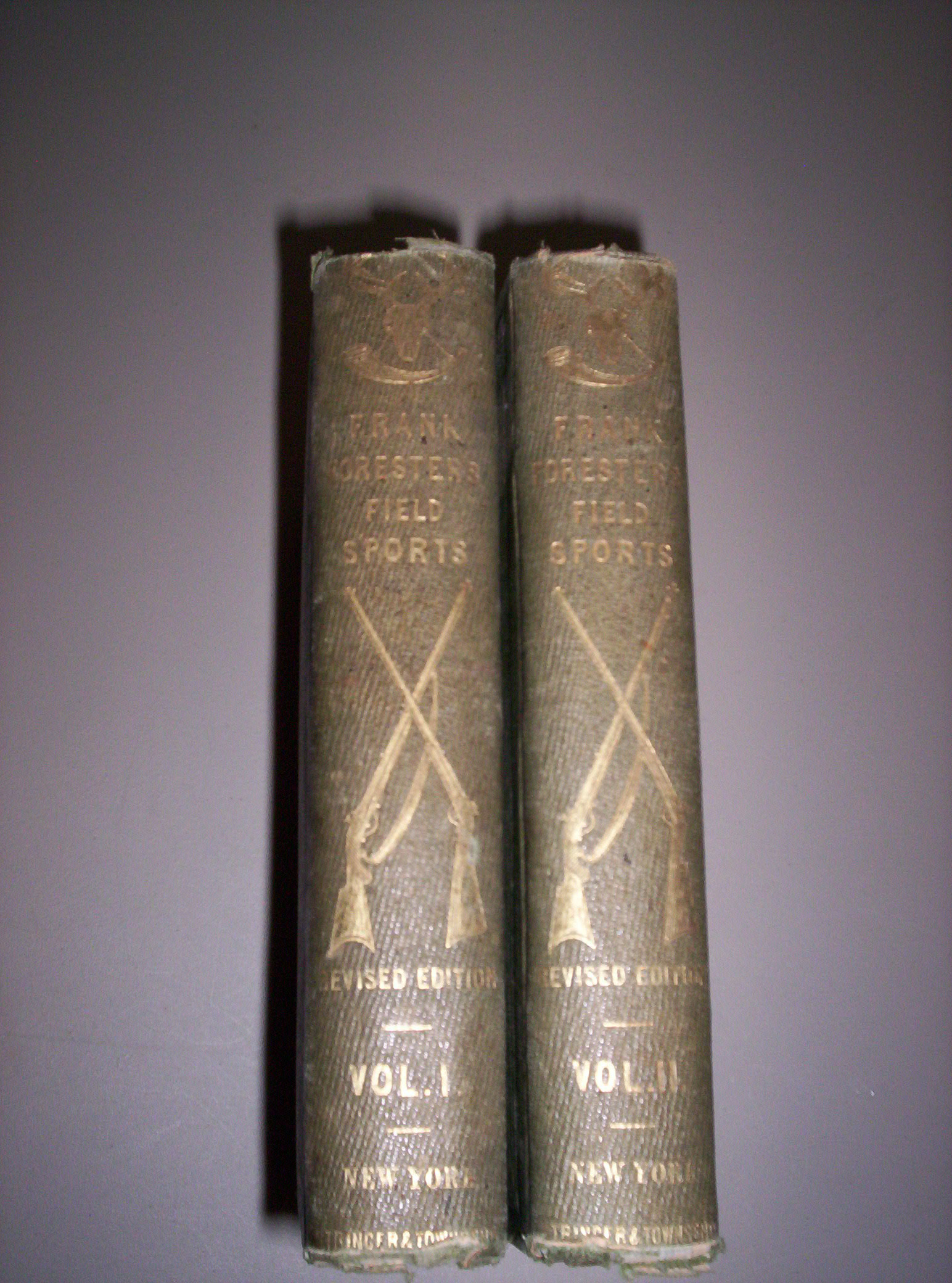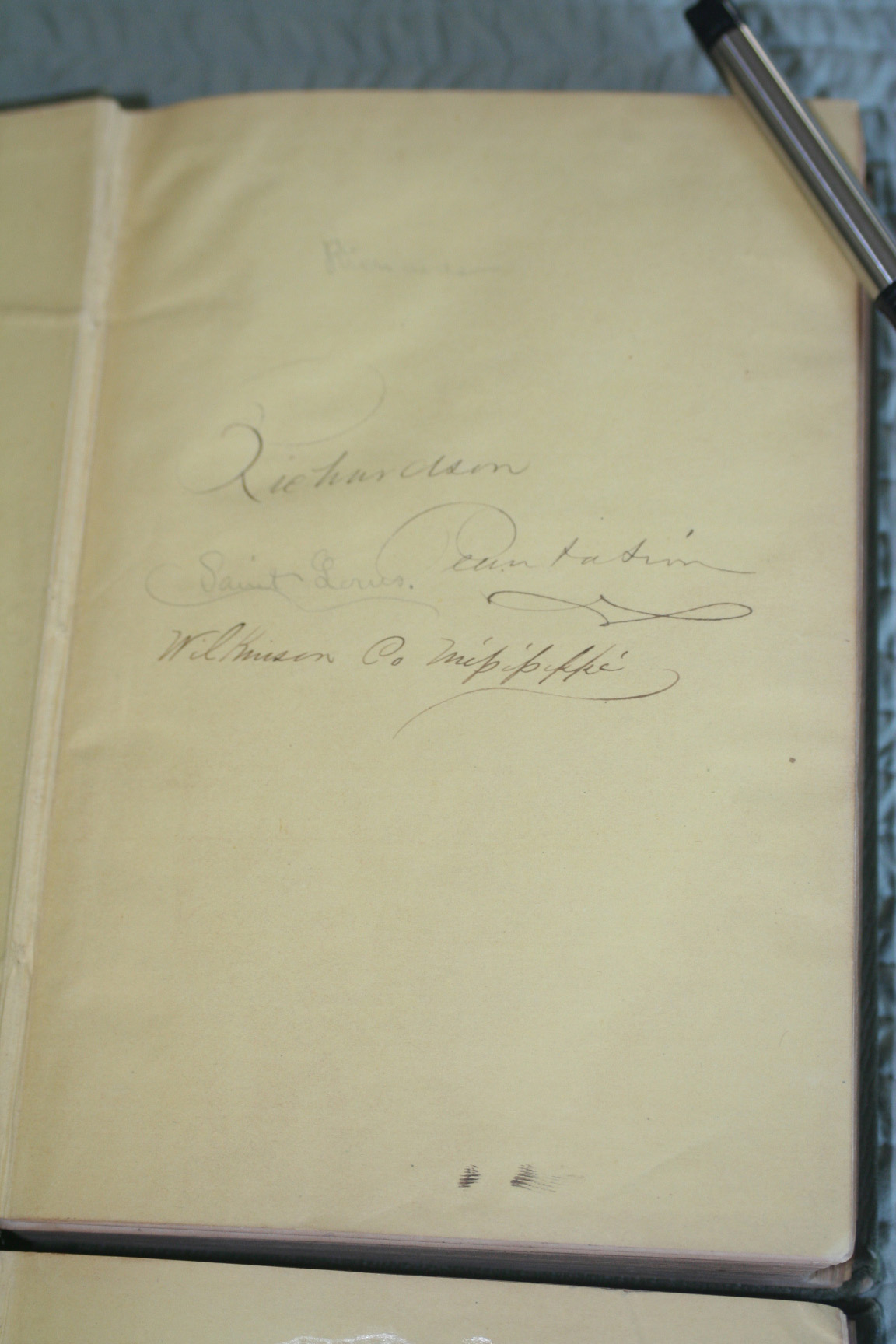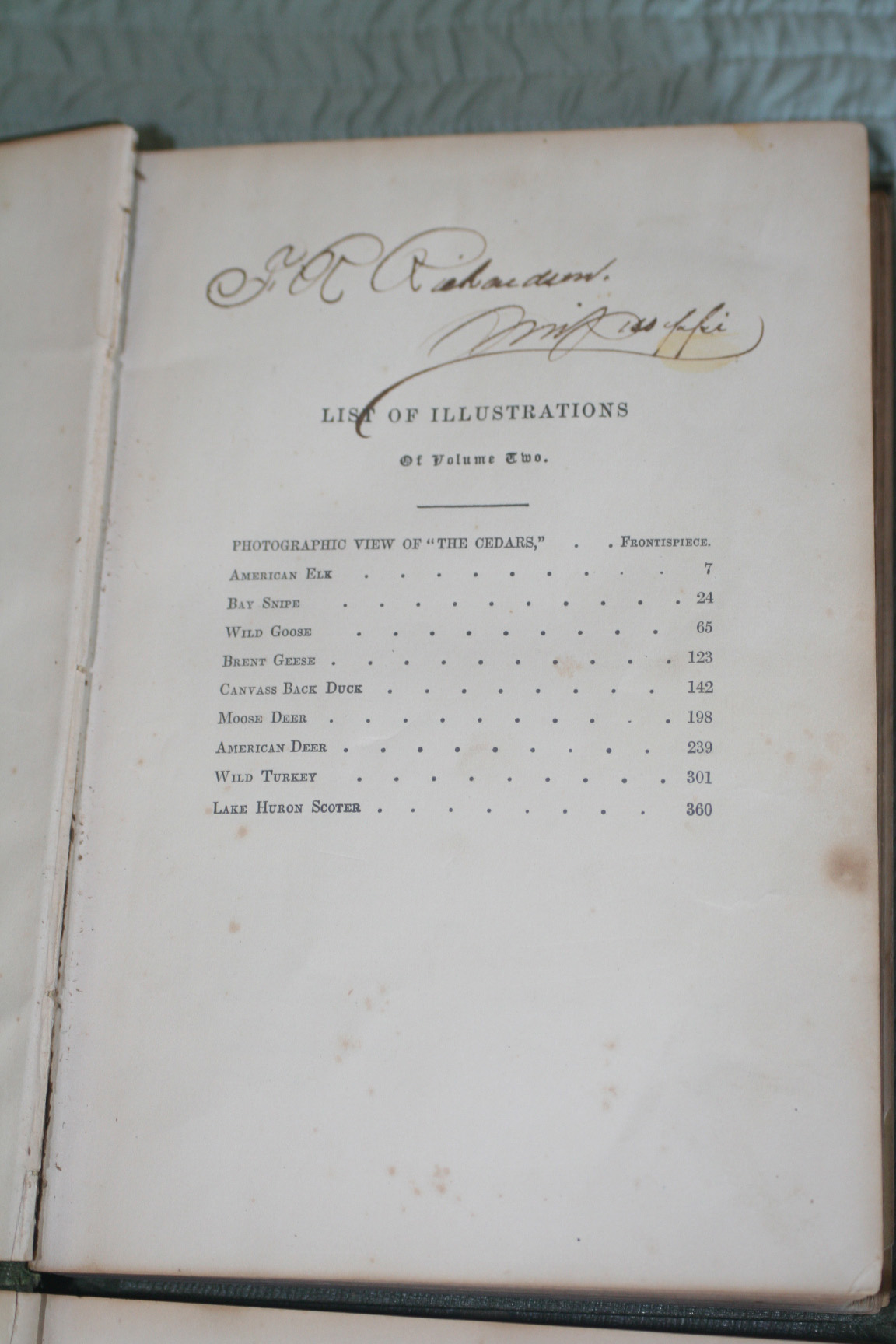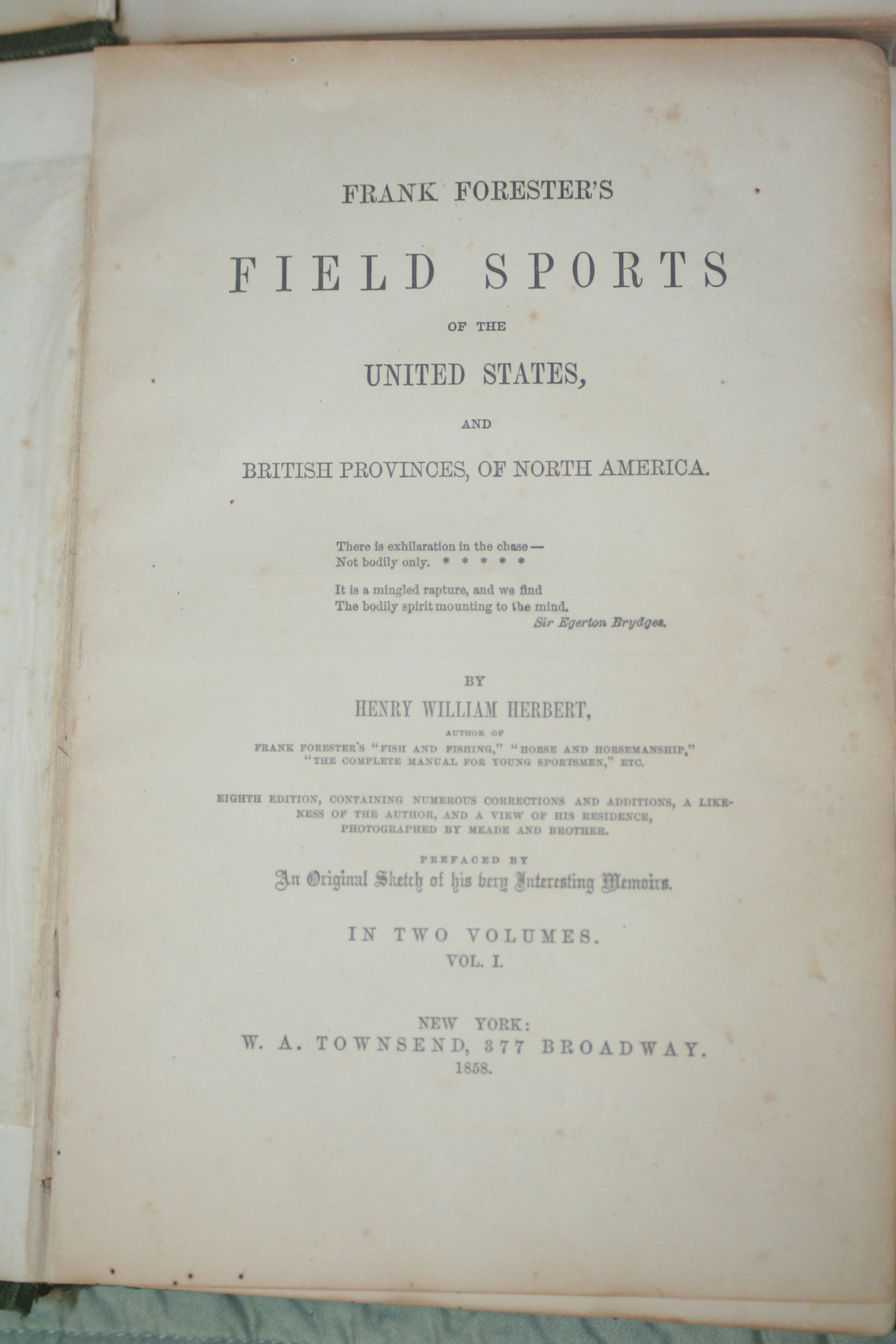Two Books From
the
Richardson Plantation,
Wilkinson County, MS
In early 2011, I received an email from an individual in Pueblo West, Colorado. I won't use his name here for privacy reasons, but, here's the story. He told me he had two books dating from the mid-1800's and inscribed as belonging to the Richardson Plantation, Wilkinson County, Mississippi. He asked if I would be interested in these books as he wanted to get them into the hands of a Richardson descendant. I accepted the offer and he sent the books to me.
These two books are volumes I and II of Frank Forester's Field Sports of the United States and British Provinces of North America.
The books are hard-bound; 6 inches wide by 8-1/2 inches tall by 1-1/2 inches thick. Information on the title page states these are the eighth edition, dated 1858.
Author and subject matter
"Frank Forester" is the pen-name of Henry William Herbert (1807 - 1858). Here is a short biography of Herbert found on the Lehigh University Digital Library.
Henry William Herbert is best known by his sportswriter pseudonym: Frank Forester. Herbert emigrated to the United States in 1831 and he spent the following eight years working as a professor of Latin and Greek at a New York City school. Starr explains that his brilliance as a teacher was undeniable for ďas a classical scholar he had few equals in this country . . . his knowledge of English history and literature was extensive; he was a pen-and-ink artist of marked ability; as a sportsman he was unsurpassed; his pupils idolized him.Ē
Herbert eventually left his teaching job and devoted himself entirely to his writing career. He co-founded the American Monthly Magazine in 1833 and, in 1835, he anonymously published the historical romance, The Brothers, a Tale of the Fronde. He published several other novels before transitioning into the mode of historical writing. He wrote The Knights of England, France, and Scotland (1852), The Captains of the Roman Republic (1854) and also continued to publish work in periodicals.
In 1839 Herbert began writing for the American Turf Register under the alias ďFrank Forester.Ē As Forester, he published The Warwick Woodlands, or Things as They Were There Ten Years Ago (1845),My Shooting Box 1846, The Deerstalkers (1849), Frank Foresterís Field of Sports of the United States, and British Provinces, of North America (1849), The Quorndon Hounds; or A Virginian at Melton Mowbray (1852), The Complete Manual for Young Sportsmen (1856), and Frank Foresterís Horse and Horsemanship of the United States and British Provinces of North America (1857). These books also highlighted Herbertís artistic ability--he drew many of the illustrations found within them.
Herbert committed suicide in 1858. His wife left him after only a few weeks of marriage and her departure brought on a fit of depression, which ended when he shot himself.
I have found other sources stating the two volumes of Field Sports of the United States and British Provinces of North America were very popular for many years and were a standard reference for hunters. The books contain descriptions of many (most ?) game animals in North America -- elk, deer, bear, birds, etc. -- and detailed discussions of guns, dogs, hunting, and hunting equipment.
Photos
Here are photos of pages inside the books.
Flyleaf inscriptions
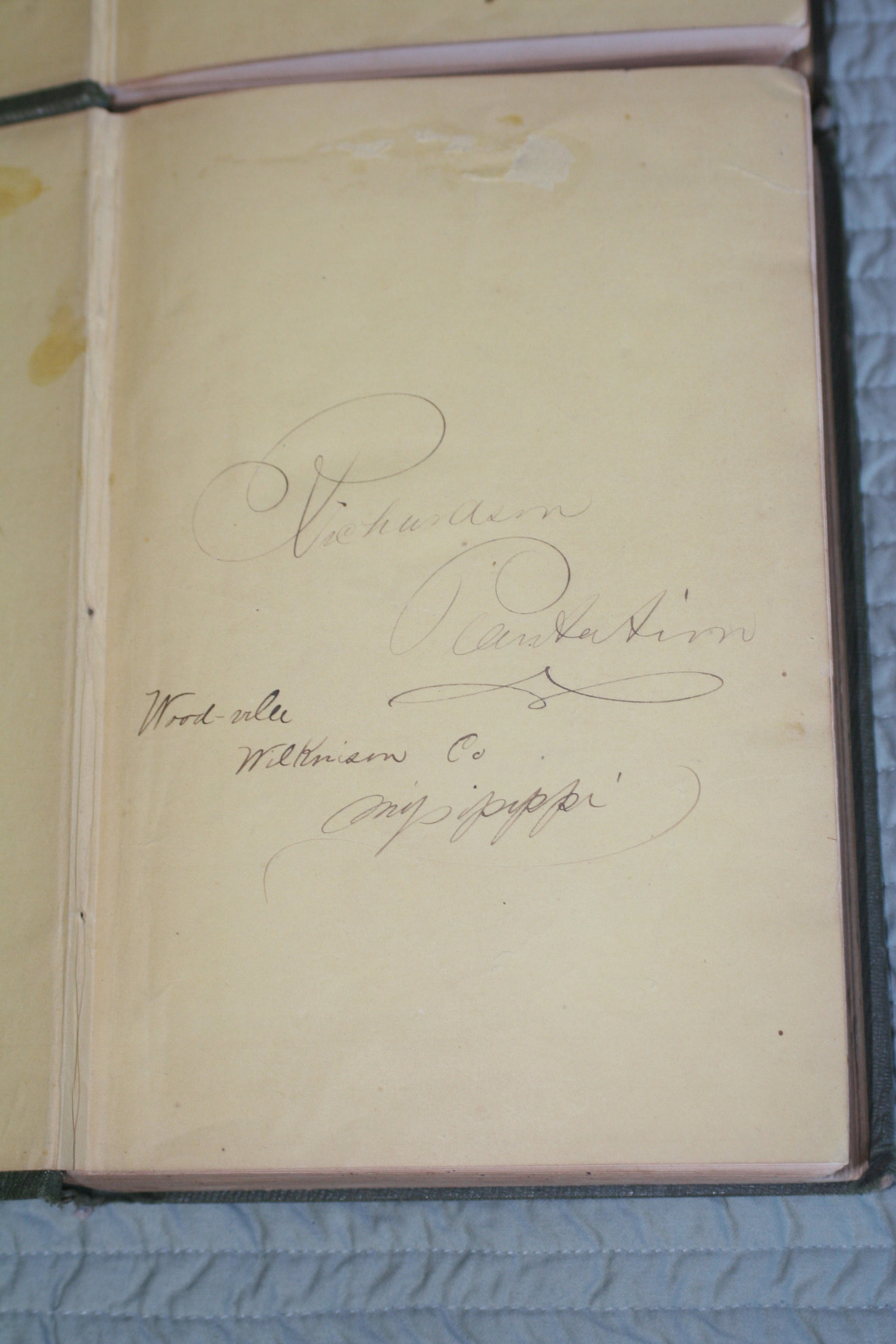
Each book is inscribed on the flyleaf. Volume I, on the left, is inscribed: "Richardson Plantation, Wood-ville, Wilkinson Co., Mississippi." Volume II, on the right, is inscribed: "Richardson Plantation, Wilkinson Co., Mississippi." On the flyleaf of Volume II, next to the word "Plantation" is written in pencil: "Saint Louis." More about this later.
F. R. Richardson signature
The signature at the top of the page, Volume II, is: "F. R. Richardson, Mississippi."
Francis Rivers Richardson's signature and problems with the dates
I believe "F. R. Richardson" is Francis Rivers Richardson (Abt. 1800 - 1841), son of Francis Richardson (1763 - 1820); Francis Rivers Richardson was born about 1800 in South Carolina. HOWEVER -- there is a real problem here. As best I can determine, Francis Rivers Richardson, born 1800 in South Carolina, died in 1841. Information on the title page states these are the eighth edition, dated 1858. Thus, if these books were published in 1858, then, Francis Rivers Richardson -- born circa 1800, died 1841 -- could not have signed the books. The following discussion is an attempt to determine just how Francis Rivers Richardson's name was written on the flyleaf of a book that was published several years after his death.
Information about Francis Rivers Richardson
Information about Francis Rivers Richardson (18?? -
1841) is sketchy and comes from several sources. The following
information is working notes as of August 2015 as I attempt to reconcile
the date of publication (1858) with Francis Rivers Richardson's death in
1841. In these notes, Francis Rivers Richardson will be referred
to as FRR.
SOURCE: 2015: Rivers Lelong, a descendant of John Gaulden
Richardson, resident of New Orleans, has a collection of letters and
other documents from and about various members of the Richardson family.
In August 2015 he informed me of the content of a letter he has that
states Francis Rivers Richardson's middle name Rivers was given to him
by his father, Francis Richardson (1763-1820), Here is a quote from a
message to me from Rivers Lelong:
". . . Per Francis Dubose, Francis Richardson added the middle name
Rivers to his sonís name to honor Francis Richardsonís good friend
Francis Rivers of South Carolina. I have a copy of that record written
by Francis Dubose and in our branch of the family the oral family
tradition is also clear that the original Francis Richardson did not
have the middle name Rivers and that we are not descended from the
Rivers family of South Carolina (as you likely know, a very old and
widespread family; I meet members of that family from time to time)."
-------------------------------------------------------
Francis Rivers Richardson's birthdate is unknown, as of August 2015. I
found information on several family trees on the Ancestry.com website
stating his birthdate is "Circa 1800." However, because much of the
information on these family trees is suspect, I will not accept that
date.
-------------------------------------------------------
The following information comes from a document produced by the
Magoffin
Family Home, a Texas state historical site in El Paso, TX. FRR's
son Charles Cunningham Richardson (1835 - 1911) married Josephine Magoffin
(1836 - 1886). They settled in the SW US, eventually building a home
in El Paso that was preserved and taken into the Texas state historical
department as an example of early SW architecture.
FRR was a student in Transylvania University, Lexington, KY, graduating
in July 1825. He married Sarah Magoffin of Harrodsburg, Mercer County,
KY, in September 1825. These facts suggest FRR met Sarah Magoffin while
he was a student at Transylvania University.
FRR and Sarah Magoffin Richardson (SMR) had several children.
++ Their first child was a daughter, Martha Gaulden Richardson, born
1826 in Wilkinson County, MS. She later married Judge Curtis Field.
++ The next two children died in infancy and were buried in the
Richardson Cemetery near Woodville, Wilkinson County, MS:
-- Beriah Richardson, 1828-1830
-- William Arthur Richardson, 1830-1834
++ A son FRR, Jr. was born 1833, died 1847. I assume he was born in Wilkinson County, MS.
He may have died in Kentucky. I say this because his father, FRR, died in
1841. His mother, Sarah Magoffin Richardson returned to her home in
Harrodsburg, Mercer County, KY, at some point after 1841 (see discussion of
slave sales, below).
++ A son Charles Cunningham Richardson (1835 - 1911) was born in
Wilkinson County, MS.
++ Some records show their last child was a daughter, Sarah Jane
Richardson, b. 18??, d. ???.
These facts indicate FRR and SMR moved to the Richardson Plantation in
Wilkinson County, MS, shortly after their marriage.
FRR died in June 1841. This information is contained in notices posted
in the local newspaper, the Woodville Republican, vol. 2: 58, 83, and
vol. 3: 8. In these notices, FRR's brother Jared Richardson and widow
SMR were appointed executors of FRR's estate.
-------------------------------------------------------
Further evidence that he died in 1841 is found in a
document
titled "From Natchez to New Orleans: Slaves, Slave Holders and
Slavery in the Woodville Republican and Wilkinson County Advertiser,
1832 - 1849," compiled by Roberta Louise Burns Hoffman, 1998.
This document is 333 pages long and contains notices of runaway slaves;
notices of slaves for sale, editorials and articles about slavery from
the two newspapers.
On pages 191 and 192 of this document are 14 advertisements of slaves
for sale from the estate of FRANCIS H. RICHARDSON by Jared N. Richardson
and Sarah M. Richardson, executors of the estate of FRANCIS H.
RICHARDSON who died in June 1841. I suspect the "FRANCIS H. RICHARDSON"
is an error and these notices refer to slaves in the estate of FRANCIS
RIVERS RICHARDSON. This document, then, indicates he died in June 1841.
Thirteen of these fourteen advertisements are dated February 1845 and cite Jared N. Richardson and Sarah M. (Magoffin) Richardson as executors of FRR's estate. This does not necessarily mean Sarah Magoffin Richardson was still in Mississippi as of February 1845 -- she could have designated Jared to close her late husband's estate while she returned home to Kentucky.
None of this answers the question of how Francis Rivers Richardson's signature appears in a book that was published 17 years after his death. As of August 2015, I'm still researching this matter -- see below for one possibility.
Richardson Family: SC to MS
In the early 1800's there was a large migration from the Carolinas and Virginia to new land in "the West" -- Mississippi, Louisiana, Arkansas, and Texas. The Richardson's were prominent in SC where they were planters and owned large plantations. Some of them sold their land in SC and headed west to MS.
-
Francis Richardson (1760-1820) was born in SC, and married Martha Gaulden. He and two of his sons led their families in the migration from SC to MS in 1809-1810. These two sons were:
-
John Gaulden Richardson (1785 - 1856), and,
-
James B. Richardson (1789 - 1859). My great-great-grandfather is Robert Reilly Richardson (1813 - 1874), son of James B. Richardson.
-
Among the family was the young Francis Rivers Richardson (Jr.), born 1800 in SC.
-
My g-g-grandfather R. R. Richardson owned a large plantation in Wilkinson County, near Woodville. I don't know the exact size of the Richardson Plantation but I have heard that it was 6,000, 8,000, or 12,000 acres. In the 1860 slave census, R. R. Richardson owned 83 slaves.
For details, see the Memoirs of Francis Dubose Richardson.
Provenance of these two books
Richardson - Glasgow - Magoffin
The individual in Colorado who gave the books to me stated:
These books were given to me years ago by my long-time friend COL Harry A. Lucker. Harry's mother was a daughter of GEN William Glasgow. William's wife was a Magoffin, her father was Joseph Magoffin. Joseph's father was James Wiley Magoffin. James Wiley was a Santa Fe Trail trader who enable the bloodless conquest of New Mexico. Joseph Magoffin built the Magoffin home in El Paso in 1875. The book was in the Magoffin homestead until given to me.
Francis Rivers Richardson's "signature:" How did it get into the books that were published AFTER his death?
As we consider the question of how Francis Rivers Richardson's "signature" -- F.R.Richardson -- is in a book that was published 17 years after his death, it is important to remember the comments by the individual from whom I obtained these books -- the books came from the Magoffin homestead (in El Paso, Texas).
The Magoffin Connection
Because Francis Rivers Richardson (1800? - 1841) married Sarah Magoffin of Kentucky, and because these books came from the Magoffin homestead in Texas, the signature could have been added by a Magoffin family member. Remember: As stated previously these books were not printed until 1858 and Francis Rivers Richardson died in 1841 -- thus, it is not possible that Francis Rivers Richardson signed these books.
One possibility is this: The Richardson family plantation in Wilkinson County, MS, was named "Good Intent." The plantation remained in the Richardson family hands for several years after the Civil War. However, as described in the book "The Plantation World of Wilkinson County Mississippi 1792-2012,"
". . . Good Intent was divided among the Richardson family descendants and parts of it were sold. In the process, the name Good Intent became an all-but-forgotten term in the county."
It is possible these books were purchased by a Richardson after their publication in 1858 while Good Intent Plantation was still in the Richardson family. The inscriptions "Richardson Plantation, Woodville, Wilkinson County, Mississippi," could have been added at that time. Because of the connections between the Richardson and Magoffin families, at some point when the Good Intent plantation was being broken up, some of the property at the plantation may have been given to the Magoffin family because of their connection to the Richardson's. If this is the case, someone (a Magoffin ?) who received these books may have written the inscriptions in the books, including writing "F. R. Richardson, Mississippi" to indicate where the books originated.
Saint Louis
As you see in the photo of the flyleaves, one of the books has a penciled inscription "Saint Louis." Inside the back cover of that book is written, also in pencil: Saint Louis Pine Street No 1121.
I have in my family history files a copy of a letter from my great-great-grandfather Robert Riley Richardson (25 January 1812 Ė 16 March 1874) in Jackson, LA, to his cousin F. D. (Francis DuBose) Richardson in St. Louis, MO. The letter is dated 6 March 1874. Robert Riley Richardson died ten days after writing this letter, 16 March 1874. F. D. Richardson likely moved to St. Louis to escape the financial difficulties that persisted in the South for decades after the Civil War.
Francis Rivers Richardson and Sarah Magoffin Richardson's youngest child was Charles Cunningham Richardson; he married Josephine Magoffin. They lived in the St. Louis area for at least 1860 - 1866, and possibly at other times.
Thus, it is possible, in the period 1860 - 1866, when Charles C. Richardson and his wife were in the St. Louis area, he somehow obtained these books from the Richardson plantation and he wrote the inscriptions -- including writing his father's name "F. R. Richardson" to indicate the origin of the books.
One more photo
Finally, here is one more photo -- the title page from Volume I.
Back to Richardson Family first page.
